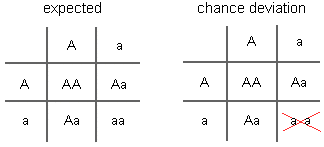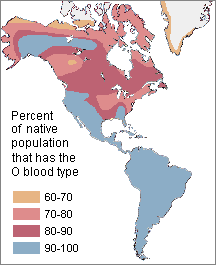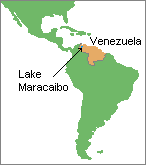Genetic Drift
In small,
reproductively isolated populations, special circumstances exist that can produce rapid
changes in gene frequencies totally independent of mutation and natural
selection. These changes are due solely to chance factors.
The smaller the
population, the more susceptible it is to such random changes.
This phenomenon is
known as genetic drift.
In order to get a better
understanding of the potential effect of population size on evolution, it is useful to
carry out a simple coin flipping experiment. The expectation is that heads will
turn up 50% of the time because there are only two sides to a coin--heads
and tails. If you flip a coin 10 times, it may or may not result in 5
heads.
 Coin flipping experiment.
Take a coin out of your pocket.
Flip it 10 times and record the results.
Coin flipping experiment.
Take a coin out of your pocket.
Flip it 10 times and record the results.
Repeat
the experiment twice. Calculate the percentage of times
the coin came up heads in each of
your three experiments and,
finally, in all of your experiments combined. What did you
learn? |
The more times that you flip your coin, the more
likely it will approach the expected 50% heads. If you do it an infinite
number of times, it will be 50%. In other words, when a sample is very
small, the probable outcome may not occur. As the sample increases in
size, it will get progressively closer to it.
This kind of deviation from the
expected outcome with small samples also occurs in genetic inheritance when breeding
populations are very small. For
example, when
women and their mates are both heterozygous (Aa) for a trait, we would expect that
25% of their children will be homozygous
recessive (aa).
By chance, however, a
particular couple might not have any children with this genotype
(as shown below in the Punnett square on the right).
|
 |
|
genotypes of children
25% AA
50% Aa
25% aa |
genotypes of children
33.3% AA
66.7% Aa
0.0% aa |
Unless other families have an
unpredictably large number of homozygous recessive (aa) children for this trait
to counter the random deviation, the population's gene pool frequencies will change in
the direction of having fewer recessive alleles--genetic
drift will occur.
The net
effect of genetic drift on a small population's gene pool can be rapid evolution, as
illustrated in the hypothetical inheritance patterns shown below. Note that the red
trait dramatically increases in frequency from generation to generation. It is important to
remember that this can occur independent of natural selection or any other evolutionary
mechanism.
 |
Rapid genetic drift over three
generations |
Such
distorting statistical anomalies occur regularly. In small populations, they can
have a rapid, significant effect on gene pool frequencies of subsequent generations.
In large populations, however, they are commonly neutralized by other families having
children with countering genotypes.
Since genetic
drift is measurably effective only in small populations, it must have played a major role
in the early stages of human evolution when our populations were tiny. However, even
in large societies, such as the United States today, there are small, culturally isolated
communities like the Amish and Dunkers of rural Pennsylvania and the Midwest that are mostly closed
breeding groups. In such sub-populations, genetic drift is still an important
evolutionary mechanism.
Founder Principle
Another
important small population effect is known as the founder
principle or founder
effect.
This occurs when a small amount of people have many descendants surviving after a number
of generations. The result for a population is often high frequencies of specific
genetic traits inherited from the few common ancestors who first had them.
In the Lake Maracaibo region of northwest
Venezuela, for instance, there is an extraordinarily high frequency of a
severe genetically
inherited degenerative nerve disorder known as Huntington's disease. Approximately
150 people in the area during the 1990's had this rare fatal condition and
many others
were at
high risk for developing it. This disease usually
does not strike until early middle age, after most people have had their children.
However, Huntington's can occur much earlier. About 10% of its victims
develop symptoms when they are younger than 20 years old. There is no
cure for this disease, but there has been a test for its genetic marker
available since 1993. All of the
Lake Maracaibo region Huntington's disease victims trace their ancestry to
a woman named Maria Concepcin
Soto who moved
into the area in the 19th century. She had an unusually large number of
descendants and was therefore the "founder" of
what is now a population of about 20,000 people with
a high risk of having this
unpleasant genetically inherited trait.
|
|
| |

|
NOTE:
Huntington's
disease is not unique to the Lake Maracaibo region. It occurs
throughout the world at relatively low rates. About 200,000 people in
the United States (.07% of the population) have it. Perhaps, the most
well-known victim of Huntington's was the American folk song writer and
performer Woody Guthrie.
Another
example of the founder effect has been discovered among the 16-18,000 Old
Order Amish people of Lancaster County, Pennsylvania. They are descended
from a few dozen individuals belonging to an Anabaptist sect in Germany who migrated to Pennsylvania
during the early 1700's. Over the last 40 years of
the 20th century, 61 babies with an
extremely rare fatal genetic disorder known as
microcephaly
 were born to 23 Amish families. All of
these families are descendants of a single Amish couple nine generations ago.
They were the founders of the population with the genes for microcephaly
today.
were born to 23 Amish families. All of
these families are descendants of a single Amish couple nine generations ago.
They were the founders of the population with the genes for microcephaly
today.
It is also possible to find the results of
a founder event even though the original ancestors are unknown. For example,
South and Central American Indians were nearly 100% type O for the ABO blood system and 100% positive for the Rh blood system.
Since nothing in nature seems to strongly select for or against
blood types, it is likely
that most of these people are descended from a small band of closely related
"founders" who also shared these
traits. They migrated into the
region from the north, probably by the end of the last Ice Age.
Bottleneck Effect
In many
species, there have been catastrophic periods caused by
rapid dramatic changes in
natural selection, during which most individuals died without passing on their genes.
The few survivors of these evolutionary "bottlenecks" then were reproductively very
successful, resulting in large populations in subsequent generations. The
consequence of
this bottleneck effect is the extraordinary reduction in genetic diversity of a species
since most variability is lost at the time of the bottleneck.
Bottlenecking also occurs at times in
human populations as a result of major epidemics and catastrophic storms,
earthquakes, and volcanic eruptions. An example of this occurred on
the small Micronesian island of Pingelap in the Western Pacific. In
1775, a typhoon killed at least 90% of its people, thereby eliminating most
of the genetic variation. One of the 20
survivors was a man named Nahnmwarki Mwanenised.
He had achromatopsia, a very rare genetically inherited recessive eye condition that
causes total color blindness and extreme sensitivity to light. Six generations
later, nearly 5% of the island's population had achromatopsia. All of
those who had it were descendents of
Nahnmwarki Mwanenised. By comparison, only 1 in 33,000 people
in the United States have it. Not only did the Pinegleapese experience a dramatically
reduced genetic diversity as a result of the 18th century storm, but
unfortunately that surviving gene pool contained the genes for achromatopsia,
making this an example of both the bottlenecking effect and the founder
principle.




